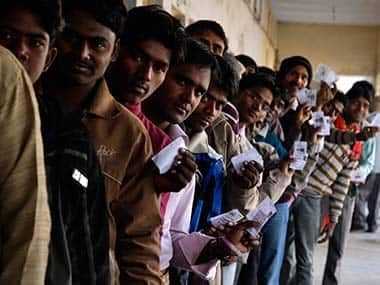Inflation is up. Growth rate is down. And jobs are increasingly scarce. Yet at this moment of impending crisis, both national parties seem to be suffering from a serious ‘vision’ problem — blind to a new generation of Indian voters who are looking for more than politics as usual, be it government handouts or identity politics. And these young Indians may well determine their fate, come 2014. “Hope for India may well lie with its aspiring young people, those who are in the middle class or about to reach it. They are about a third of the country now, and will be half in a decade,” writes Gurcharan Das in the Financial Times, “They have no one to vote for because no politician talks the language of public goods or governance. The existing parties treat voters as poor, ignorant masses who need to be appeased at election time with populist giveaways.” [Available to subscribers
here
] This aspirational electorate also creates a “political space that should be filled by a secular party at the right of centre,” argues Das, but notes that “none of the existing parties is likely to fill it. The only answer for aspiring India may well be a new liberal party, which trusts markets rather than officials and focuses on the reform of institutions. This party might not win votes quickly but it could bring governance reform to centre stage and gradually prove to voters that open markets and rules-based government are the only civilised ways to lift living standards and achieve shared prosperity.” For an Indian reader, Das’ op-ed is exasperatingly vague. He refuses to name names, and therefore doesn’t have to explain why, say, Narendra Modi’s attempt to fill precise that centre-right space — and move away from Hindutva politics — will be unsuccessful. Nor does he make clear if Arvind Kejriwal’s Aam Aadmi Party can be that so-called new liberal party. Such are the liberties allowed an Indian columnist when writing for a foreign audience. [caption id=“attachment_668341” align=“alignleft” width=“380”]
 File photo of voters in Uttar Pradesh. Reuters[/caption] More intriguing is Devangshu Datta’s
essay
in Open Magazine which explores some of the same themes, but with greater substance and persuasion. “An estimated 110 million people will be eligible to vote for the first time in 2014. Another 45 million came of voting age in 2009. Put them together, along with those who cast their first votes in various assembly polls inbetween, and almost 25 per cent of the electorate is aged 18-27,” notes Datta, arguing that this new voter is relatively more literate, sophisticated thanks to internet access, and immune to old hot-button issues such as Babri Masjid, 1984 riots and Godhra. Most importantly, they are increasingly urban:
File photo of voters in Uttar Pradesh. Reuters[/caption] More intriguing is Devangshu Datta’s
essay
in Open Magazine which explores some of the same themes, but with greater substance and persuasion. “An estimated 110 million people will be eligible to vote for the first time in 2014. Another 45 million came of voting age in 2009. Put them together, along with those who cast their first votes in various assembly polls inbetween, and almost 25 per cent of the electorate is aged 18-27,” notes Datta, arguing that this new voter is relatively more literate, sophisticated thanks to internet access, and immune to old hot-button issues such as Babri Masjid, 1984 riots and Godhra. Most importantly, they are increasingly urban:
India is in the middle of the biggest migration in human history. Millions of young people have shifted from villages to cities over the past ten years and more are doing so even as you read this. Approximately one-third of all voters are now urban, and urban centres are represented by about 200 Lok Sabha seats. Another 50-100 seats include several urban segments. Urban voter behaviour is different from rural voter behaviour. Issues of local logistics and economics dominate urban seats, while caste lines, so clear-cut in rural areas, blur.
Viewed in this context, opting for MNREGA-style electoral handouts instead of employment constitutes a serious political blunder because “every rural denizen who chooses to forgo handouts of the MNREGA, and comes to the city instead, is saying, ‘I want a proper job.’” Equally misplaced is the traditional electoral strategy — common to all parties— centred on identity, be it caste, region or religion. And that’s not just because of a demographic shift, argues Datta, but the typically high “electoral volatility” of Indian voters, 26 percent of whom shift allegiances from one election to another.
High electoral volatility also suggests that the axiomatic insistence on identity politics isn’t necessarily the best strategy. Identity doesn’t change but voteshare does shift dramatically from election to election. One way of trying to reconcile an electoral strategy with this volatility is to assume that every political party plays the caste-cum-religious cards as best it can. So the differentiator eventually becomes good governance and the economic policies that voters actually like.
Datta too doesn’t get into the messy business of analysing the fortunes of any one party or leader. But he certainly makes a case for an impending youth-driven paradigm shift in Indian politics. Read “Democracy as a Demographic Puzzle” here .
)